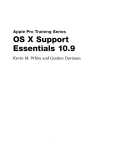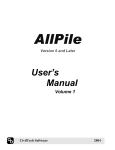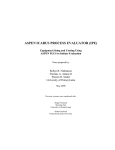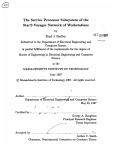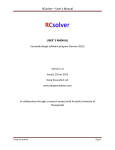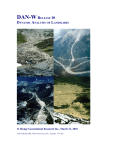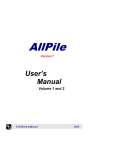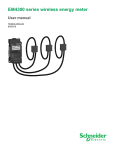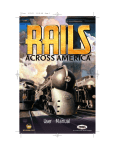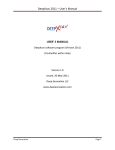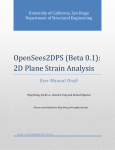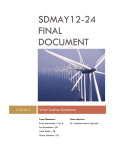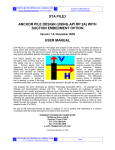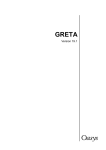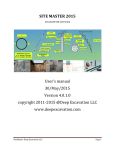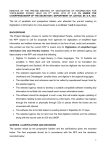Download HelixPile 2012 – User`s Manual USER` S
Transcript
HelixPile 2012 – User’s Manual USER’ S MANUAL HelixPile software program (Version 2012) Version 1.0 Issued: 12‐March‐2012 Deep Excavation LLC www.deepexcavation.com DeepExcavationLLC Page1 HelixPile 2012 – User’s Manual Table of Contents Chapter 1: Introduction to HelixPile ............................................................................................................. 4 1.1 About HelixPile (Helical Pile Engineering Program) ............................................................................ 5 1.2 Software Compatibility & Installation ................................................................................................. 5 1.3 Support & Technical Assistance .......................................................................................................... 5 1.4 Acknowledgements ............................................................................................................................. 5 1.5 End User License Agreement .............................................................................................................. 5 1.5 Activating the software ....................................................................................................................... 8 Chapter 2: Using HelixPile ........................................................................................................................... 10 2.1 Using HelixPile ................................................................................................................................... 11 2.2.1 HelixPile Toolbar Functions ............................................................................................................ 12 2.2.2 Design Section List, and Project Tree View .................................................................................... 15 2.3 General menu ................................................................................................................................... 16 2.4 Properties menu ............................................................................................................................... 23 2.5 Model menu ...................................................................................................................................... 29 2.6 Settings menu ................................................................................................................................... 31 2.7 Design menu ..................................................................................................................................... 33 2.8 Results menu ..................................................................................................................................... 34 2.9 Report menu .................................................................................................................................... 34 2.10 View menu ...................................................................................................................................... 35 2.11 Help menu ....................................................................................................................................... 36 Chapter 3: Data Entry .................................................................................................................................. 37 3.1 Data entry: General ........................................................................................................................... 38 3.2 Data entry: Project information ........................................................................................................ 39 3.3 Data entry: Soil Data ......................................................................................................................... 40 3.4 Data entry: Soil Layers ...................................................................................................................... 44 3.5 Data entry: Helical Piles .................................................................................................................... 45 Chapter 4: Modifying Models & Viewing Results ....................................................................................... 47 4.1 Adding Pile Loads .............................................................................................................................. 48 4.2 Viewing Results on Main Form ......................................................................................................... 49 DeepExcavationLLC Page2 HelixPile 2012 – User’s Manual 4.3 Report Options (Printed Reports) ..................................................................................................... 50 Chapter 5: Theoretical background ............................................................................................................ 52 5.1 Theoretical background .................................................................................................................... 53 5.2: Shaft side resistance ........................................................................................................................ 55 5.3 Cylinder strength method ................................................................................................................. 57 5.4 Structural capacity calculations ........................................................................................................ 57 References .................................................................................................................................................. 60 DeepExcavationLLC Page3 HelixPile 2012 – User’s Manual Chapter 1: Introduction to HelixPile DeepExcavationLLC Page4 HelixPile 2012 – User’s Manual 1.1 About HelixPile (Helical Pile Engineering Program) HelixPile 2012 is a user friendly, modern and powerful software program for the design of helical piles. HelixPile allows the user to include an unlimited number of stage conditions and soil profiles. HelixPile incorporates the latest recommendations and reports the controlling design design conditions. 1.2 Software Compatibility & Installation HelixPile is compatible with Windows (OS) XP, Vista and 7. A minimum of 120 Mb must be available on your hard disk. 1.3 Support & Technical Assistance Support and technical assistance for HelixPile is offered through our web site at: www.deepexcavation.com 1.4Acknowledgements Deep Excavation LLC would like to acknowledge the contribution of Howard Perko from Magnum Piering, who has been extremely helpful when the program authors had questions regarding helical pile design. 1.5 End User License Agreement Deep Excavation makes every effort to ensure quality and accuracy of computations performed by Steel Connect. However, the end user (you) assumes full responsibility for the applicability of the results to actual projects as described in the License Agreement that follows. If you decide to use HelixPile 1.0 you agree to abide by the terms and conditions described in the License Agreement. HelixPile 2012 "TERMS OF USE / LICENSE AGREEMENT" This legal document is an agreement between you (the end user) and Deep Excavation. BY CONTINUING WITH/OPENING/DOWNLOADING THIS SOFTWARE PROGRAM, YOU ARE AGREEING TO BECOME BOUND BY THE TERMS OF THIS AGREEMENT, WHICH INCLUDES THE SOFTWARE LICENSE, SOFTWARE DISCLAIMER OF WARRANTY, AND HARDWARE LIMITED WARRANTY "collectively the "Agreement". This agreement constitutes the complete agreement between you and Deep Excavation. IF YOU DO NOT AGREE TO THE TERMS OF THIS AGREEMENT, DO NOT CONTINUE WITH THIS SOFTWARE PROGRAM. Promptly return or delete the software program (cd and jewel case) and other items that are part of this product to Deep Excavation, for a complete refund if a purchasing fee was charged. HelixPile "SOFTWARE LICENSE" DeepExcavationLLC Page5 HelixPile 2012 – User’s Manual THE LICENSE APPLIES TO PURCHASED AND FREE OF PURCHASE VERSIONS OF THE HelixPile SOFTWARE. LICENSE. In consideration of payment of the LICENSE fee, which is a part of the price you paid for this product, Deep Excavation, as Licensor grants to you, the LICENSEE, a nonexclusive right to use and display this copy of HELIXPILE, Software (hereinafter referred to as "SOFTWARE or HelixPile" on a single COMPUTER (i.e., with a single CPU) at a single location. Any "networking", namely operating this program on a "network" is strictly forbidden. You as a Licensee are strictly forbidden to operate, utilize, transfer, distribute, connect, network, link to, attach, or operate in any manner this software on the internet, worldwide web, via email, any website, networking, any multimedia device, electronic or otherwise or any form of electronic media whatsoever. This includes but is not limited to the written materials, results, output, or resulting answers and/or printed matter without the prior written consent of Deep Excavation. Deep Excavation reserves all rights not expressly granted to LICENSEE. SOFTWARE OWNERSHIP. As the LICENSEE, you own the magnetic or other physical media on which the SOFTWARE is originally or subsequently recorded or fixed, however, Deep Excavation retains title and ownership of the SOFTWARE recorded on the original disk copy(ies) and any subsequent copies of the SOFTWARE, regardless of the form or media in or on which the original and other copies may exist. This License is not a sale of the original SOFTWARE or any copy thereof. COPY AND/OR MODIFY RESTRICTIONS. This Licensed Product is copyrighted (copyright 2004 Deep Excavation) and may not be further copied, without the prior written approval of Deep Excavation except that You may make one copy for backup purposes provided You reproduce and include the complete copyright notice, disclaimer, etc., on the backup copy. Any unauthorized copying is in violation of this Agreement and also a violation of the United States Copyright law. You may not use, transfer, modify, copy of otherwise reproduce the License Product, or any part of it, except as expressly permitted in this End User License Agreement. USE RESTRICTIONS. As the LICENSEE, you may physically transfer the SOFTWARE from one computer to another provided that the SOFTWARE is used on only one computer at a time. You may not electronically transfer the SOFTWARE from one computer to another over a network. You may not distribute copies of the SOFTWARE or accompanying written materials to others. You may not operate, utilize, transfer, distribute, connect, network, link to, attach, or operate in any manner this software on the internet, worldwide web, via email, any website, networking, any multimedia device, electronic or otherwise or any form of electronic media whatsoever. You may not modify, adapt, translate, reverse engineer, decompile, disassemble, or create derivative works based on the SOFTWARE. In addition, you may not modify, adapt, translate, or create derivative works based on the written materials, results, output, or resulting answers and/or printed matter without the prior written consent of Deep Excavation. RESTRICTIONS AGAINST TRANSFER. This SOFTWARE is licensed only to you, the LICENSEE, and may not be transferred to anyone without the prior written consent of DEEP EXCAVATION. Any authorized transferee of the SOFTWARE shall be bound by the terms and conditions of this Agreement. In no event may you transfer, assign, copy, rent, lease, sell, or dispose of the SOFTWARE in any manner on a temporary or permanent basis except as expressly provided herein. TERM. This End User License Agreement is effective from the date of purchase by You or granting to you of the Licensed Product and shall remain in force until terminated. You may terminate this End User License Agreement at any time by destroying the Licensed Product together with any backup copy in any form made by You or received by You. In addition, your right to use the Licensed Product will terminate if You fail to comply with any of the terms or conditions of this End User License Agreement. Upon such termination You shall destroy the copies of the Licensed Product in your possession. DISCLAIMER OF WARRANTY AND LIMITED WARRANTY THE SOFTWARE AND ACCOMPANYING WRITTEN MATERIALS (INCLUDING RESTRICTIONS FOR USE) IF ANY, ARE PROVIDED "AS IS" WITHOUT WARRANTY OF ANY KIND. FURTHER, DEEP EXCAVATION DOES DeepExcavationLLC Page6 HelixPile 2012 – User’s Manual NOT WARRANT, GUARANTEE, OR MAKE ANY REPRESENTATIONS REGARDING THE USE, OR THE RESULTS OF THIS USE, OF THE SOFTWARE OR WRITTEN MATERIALS IN TERMS OF CORRECTNESS, ACCURACY, RELIABILITY, CURRENTNESS, OR OTHERWISE. THE ENTIRE RISK AS TO THE RESULTS AND PERFORMANCE OF THE SOFTWARE IS ASSUMED BY YOU . Deep Excavation warrants to the original LICENSEE (a) the disk(s) on which the SOFTWARE is recorded to be free from defects in materials and workmanship under normal use and service for a period of sixty (60) days from the date of delivery as evidenced by a copy of the receipt. In addition, Deep Excavation hereby limits the duration of any implied warranty(ies) on the disk or such hardware to the respective period stated above. Deep Excavation's entire liability and your exclusive remedy as to the disk(s) or hardware shall be, at Deep Excavation's option, either (1) return of the purchase price or (2) replacement of the disk or hardware that does not meet Deep Excavation's Limited Warranty and which is returned to Deep Excavation with a copy of the receipt. If failure of the disk or hardware has resulted from accident, abuse or misapplication, Deep Excavation shall have no responsibility to replace the disk or hardware or refund the purchase price. Any replacement disk or hardware will be warranted for the remainder of the original warranty period or thirty (30) days, whichever is longer. THE ABOVE ARE THE ONLY WARRANTIES OF ANY KIND, EITHER EXPRESS OR IMPLIED, INCLUDING BUT NOT LIMITED TO THE IMPLIED WARRANTIES OR MERCHANTABILITY AND FITNESS FOR A PARTICULAR PURPOSE THAT ARE MADE BY DEEP EXCAVATION ON THIS PRODUCT. NO ORAL OR WRITTEN INFORMATION OR ADVICE GIVEN BY DEEP EXCAVATION, ITS DEALERS, DISTRIBUTORS, AGENTS, OR EMPLOYEES SHALL CREATE A WARRANTY OR IN ANY WAY INCREASE THE SCOPE OF THIS WARRANTY, AND YOU MAY NOT RELY ON ANY SUCH INFORMATION OR ADVICE. NEITHER DEEP EXCAVATION NOR ANYONE ELSE WHO HAS BEEN INVOLVED IN THE CREATION, PRODUCTION, OR DELIVERY OF THIS PRODUCT SHALL BE LIABLE FOR ANY DIRECT, INDIRECT, CONSEQUENTIAL, OR INCIDENTAL DAMAGES (INCLUDING DAMAGES FOR LOSS OF BUSINESS PROFITS, BUSINESS INTERRUPTION, LOSS OF BUSINESS INFORMATION, AND THE LIKE) ARISING OUT OF THE USE OF OR INABILITY TO USE SUCH PRODUCT EVEN IF DEEP EXCAVATION HAS BEEN ADVISED OF THE POSSIBILITY OF SUCH DAMAGES. IN ALL CASES A LICENCED PROFESSIONAL ENGINEER SHALL APPROVE AND STAMP ANY RESULTS BY HelixPile. AND THAT ENGINEER IS ULTIMATELY RESPONSIBLE FOR ANY CONSEQUENCES OR MISUSE OF THE SOFTWARE. This Disclaimer of Warranty and Limited Warranty is governed by the laws of the State of New York. Should you have any questions regarding this agreement please email: DeepExcavation, [email protected] DeepExcavationLLC Page7 HelixPile 2012 – User’s Manual 1.5 Activating the software In order to activate the license, the following steps are required; 1) Download and install the software. 2) Keep the SHIFT key pressed (or CAPS locked) and start HelixPile 2012 3) The activation window should appear (Figure 1.5.1). 4) E‐mail us the SITE and MID codes that appear in this window (see Figure 1.5.1). 5) We will then e‐mail back the user’s activation code 6) Restart the program (with CAPS locked) and enter the activation code in the Deep‐Paratie activation window (select the option Unlock application) (Figure 1.5.2). (please pay attention not to paste the activation code with any additional space characters) 7) Press Continue. Figure 1.5.1: The HelixPile activation window – SITE and MID codes. DeepExcavationLLC Page8 HelixPile 2012 – User’s Manual Figure 1.5.2: The activation code area. DeepExcavationLLC Page9 HelixPile 2012 – User’s Manual Chapter 2: Using HelixPile DeepExcavationLLC Page10 HelixPile 2012 – User’s Manual 2.1 Using HelixPile HelixPile is a user‐friendly software program that includes powerful features and versatile options for helical pile design. HelixPile offers the ability to work with many design sections of a model that can represent various conditions. In a sense, a design section is a design scenario. This way, multiple conditions can be examined simultaneously. The main interface is shown in Figure 2.1.1. The general philosophy in creating a model in HelixPile is: 1) Specify the global coordinates. 2) Specify the soil types and properties. 3) Specify the layers and stratigraphy. 4) Create a generalized water table. 5) Specify the pile properties (depth, x‐coordinate, number and dimensions of plates). 6) Specify different stages 7) Specify HelixPile analysis combinations and standards. 8) Analyze the project. The general tabs that appear on the top of the program have the following functions. 1. General: This tab includes general information about the project, model limits, general settings and the HelixPile analysis options. 2. Properties: This tab contains various information about Borings and soils. 3. Model: Here we can define borings, surface and water elevations and add or delete stages. 4. Settings: Here we can modify the general program settings (units, language options etc). 5. Design: In this tab we can define code options and several safety factors. 6. Results: In this tab we can select to present results directly to the screen after the analysis is performed. 7. Report: In this tab we can select options for generating output reports, or viewing calculation progress files. 8. View: In this tab we can modify various view options or generate a top view of the model. DeepExcavationLLC Page11 HelixPile 2012 – User’s Manual 9. Help: This tab provides links to help and terms of use. Figure 2.1.1: General HelixPile 2012 Interface 2.2.1 HelixPile Toolbar Functions The following section provides a detailed list of all toolbar functions. The first tab group to encounter contains the following options: Start button Figure 2.2.1: Main button DeepExcavationLLC Page12 HelixPile 2012 – User’s Manual This window provides the following options: Create a new project Save a project to a folder See and choose to open recent files Exit the program A horizontal toolbar available right under the design section list allows the user to edit section names, add new design sections etc (Figure 2.2.2). The icons are presented and described in the table below: Tool Description Edit the name of the selected design section Generate a new view of the current design section Add a new design section Delete design section Move design section up on the list Move design section down on the list Add a new design section (empty – including only stage 0) DeepExcavationLLC Page13 HelixPile 2012 – User’s Manual Figure 2.2.2: Design section toolbar. Two calculation buttons are available on the bottom left corner of the program. By pressing either of these buttons the program will analyze the desired design section and determine the estimated pile capacity. Figure 2.2.3: Calculate tools Tool Description Calculate the selected design section Calculate all design sections DeepExcavationLLC Page14 HelixPile 2012 – User’s Manual 2.2.2 Design Section List, and Project Tree View HelixPile includes a table on the left that displays all available design sections and a tree‐style project view. The tree view enables the user to quickly access vital project data, as well as visualize crucial project settings. The next table briefly describes the functionality of the design section list, and tree view items. Selects current design section, shows available design sections. Shows available design sections Pile loads (right click to add or erase) Piles (right click to add or erase) Available soil types (by clicking the user can select which soil’s properties to modify) Available boreholes (by clicking the user can select which borehole’s properties to modify) Helical anchors (by clicking the user can select to change the properties of the helical anchors) DeepExcavationLLC Page15 HelixPile 2012 – User’s Manual 2.3 General menu Figure 2.3.1: Project info, model limits, ground and water elevations, load and clay settings, load combinations, and analysis settings. ‐ Project Info: by pressing the button , we can change the project, file, company and engineer name Figure 2.3.2: Project information dialog. ‐ Move model elevation: by pressing the button entering a new top of wall elevation. , we can change the model elevation by Figure 2.3.3: Model Elevation dialog. DeepExcavationLLC Page16 HelixPile 2012 – User’s Manual The user can choose the objects to be affected by the change in elevation. These are: The design section coordinates Soil layers elevation (of current borehole) Soil layer elevations for boreholes Surface elevations Pile top elevations Surcharge elevations Elevations of all footings and buildings The top of the pile is used as the point of reference for changing all elevations. ‐ Model Dimension ‐ Limits: by pressing the button , we can change the design section name and the model Limits to create a better view of the model. Figure 2.3.4: Model Dimension – Limits dialog. This dialog includes the following options: The design section name. The model limits. Here we can define the top, bottom, left and right limits of the model. These are absolute coordinates. Angle in plane from y‐y’ axis. DeepExcavationLLC Page17 HelixPile 2012 – User’s Manual ‐ Elevations: Change the general ground elevation and define the water table. ‐ External pile loads: by pressing the button , the "Loads on Pile" dialog appears. Figure 2.3.5: Loads on Pile dialog In this dialog we can: Add or remove a pile load. Specify the load type as presented in the figure below Figure 2.3.6: Settings – Soil/Properties Tab. DeepExcavationLLC Page18 HelixPile 2012 – User’s Manual We can choose among the following options: DL LL EQ CR DW DD EH EL ES EV PS SH BR CE CT CV FR IC IM LS PL SE TG TU WA WL WS Dead load (AASHTO DC) Live load Earthquake load Force effects due to creep Dead load of wearing surfaces and utilities Downdrag load Horizontal earth pressure load Miscellaneous locked‐in force effect results Earth surcharge load Vertical pressure from dead load of earth fill Secondary forces from post‐tensioning Force effects due to shrinkage Vehicular braking force Vehicular centrifugal force Vehicular collision force Vessel collision force Friction load Ice load Vehicular dynamic load allowance Live load surcharge Pedestrian live load Force effect due to settlement Force effect due to temperature gradient Force effect due to uniform temperature Water load and stream pressure Wind on live load Wind load on structure ‐ Choose to apply the same load to all construction stages or vary the load magnitude in each stage. Define the load magnitude. Clays: Here we can define the Clay behavior choosing from the list below. Figure 2.3.7: Clay behavior options. DeepExcavationLLC Page19 HelixPile 2012 – User’s Manual ‐ Load combinations: Here we can select to general a series of load combinations from specified standards such as AASHTO, EC7 etc. Figure 2.3.8: Load combinations available in HelixPile. Analysis Settings: By pressing the button , the Helical pile analysis settings dialog appears. General tab: Here we can define the general analysis settings that control how calculations are performed. Include shaft resistance: If selected, then shaft side resistance will be included. If we opt to include shaft resistance then the following options become available. Please refer to section 5.2 for more information. Use limiting effective stress: If selected, then a maximum limiting effective stress is used for the cylinder method, for shaft side resistance, and for bearing capacity calculations. Include tip resistance: If selected, then the tip resistance will be included in the compression bearing capacity calculations. Tip resistance should be included only when the helical shaft is fully plugged. Use bearing limit: If selected, then the ultimate bearing pressure at each plate is limited according to the formula q = f γ d (Nq ‐1) where d is the helix diameter. f is commonly taken as 2 according to recommendations by Perko 2009. DeepExcavationLLC Page20 HelixPile 2012 – User’s Manual Figure 2.3.9: Helical capacity analysis settings‐General tab. Advanced tab: DeepExcavationLLC The structural allowable stress factor for determining the structural pile capacity. The fixed body and free length colors for the helical piles Choose to use custom geotechnical capacity Page21 HelixPile 2012 – User’s Manual Figure 2.3.9: Helical capacity analysis settings‐Advanced tab. Corrosion tab: Here we can: Specify the design time (or design life) of the pile. Choose the analysis method. We can choose to use the ICC Method AC355 or the AASHTO2004 Method for moderately corrosive soils. Figure 2.3.10: Helical capacity analysis settings‐Corrosion tab. DeepExcavationLLC Page22 HelixPile 2012 – User’s Manual 2.4 Properties menu Figure 2.4.1: The Properties tab menu. ‐ Edit soil type data: by pressing the button , the soil properties form appears. Here we can add, delete and modify available soils by changing their type, the general properties like unit weights, strength parameters and permeability, modify the elastoplastic parameters and modify the bond resistance for tiebacks. A soil can be used in a boring more than one time. A number of estimation tools that help the user estimate values are also included. Paragraph 3.3 includes all the options that are available in this form. Figure 2.4.2: Edit soil properties dialog. DeepExcavationLLC Page23 HelixPile 2012 – User’s Manual ‐ Borings (Soil layers): by pressing the button , the soil layer dialog appears. In this dialog we can edit the borings available for use in the project. In each boring the user can add soil layers. To do this, we can type the new soil layer’s elevation, choose the soil type from the list of soil types and define the new layers OCR and Ko. In addition, by clicking on Edit button, we can modify the selected soil’s properties (see paragraph 3.4). The coordinates X and Y refer to the plan location of the boring and do not affect analysis results. Figure 2.4.3: Edit soil layers dialog. ‐ CPT logs: by pressing the button , we can add borings and soils by using a CPT test results file as performed by Geologismiki CPT. The options of Figure 2.4.4. are available. By choosing a CPT log input file, the following dialog appears: DeepExcavationLLC Page24 HelixPile 2012 – User’s Manual Figure 2.4.4: Available options for CPT logs. The following options are available: Import from Geologismiki CPT Extract CPT to Borings and soils CPT table www.geologismiki.gr Select a CPT file to import Choose to add the soils from CPT log to the model’s soils and borings databases This opens the CPT dialog This leads to the site of Geologismiki Figure 2.4.5: Available CPT logs dialog. In this dialog we can export the CPT test borings and soils to the program’s database. DeepExcavationLLC Page25 HelixPile 2012 – User’s Manual ‐ Edit helical anchor sections: By pressing the button we can edit the structural and geotechnical properties of the helical anchor sections (can be used in tiebacks). The properties that exist on this form and can be modified are described in paragraph 3.5. Figure 2.4.6: Edit helical anchor sections dialog. ‐ Structural materials: In this area we can edit the structural material properties. The following options are available (Figure 2.4.7): Concrete Steel Figure 2.5.9: Structural material options. Edit steel properties: By pressing the Steel Materials we can edit the structural steel properties. We can import already available materials from the “Import standard steel materials” box. DeepExcavationLLC Page26 HelixPile 2012 – User’s Manual Figure 2.4.10: Edit structural steel properties dialog. In this form we can define the following properties: The steel name The yield strength Fy The ultimate strength Fu The modulus of elasticity E The density g The steel material used Import and replace selected material Import and add as a new material Edit concrete properties: By pressing the Concrete Materials we can edit the concrete properties. We can import already available materials from the “Import standard concrete materials” box. DeepExcavationLLC Page27 HelixPile 2012 – User’s Manual Figure 2.4.11: Edit concrete properties dialog. In this form we can define the following properties: The steel name The concrete strength Fc The tension strength Ft (% of compressive strength) The modulus of elasticity E The density g The standard concrete material reference standard The concrete material Import and replace selected material Import and add as a new material DeepExcavationLLC Page28 HelixPile 2012 – User’s Manual 2.5 Model menu Figure 2.5.1: The Model tab menu. ‐ Custom layers: by pressing the button , we can choose to use the Custom layer mode and use non parallel soil layers. In this mode, a model will not use a borehole to define soil layers. Instead, the user can define arbitrary layer lines from left to right and create non‐horizontal soil layer conditions. Figure 2.5.2: Custom layers mode. ‐ ‐ ‐ The option Use custom layers switches on the custom layer mode. The reset layers from boring option, resets all custom layer lines to horizontal using the boring applicable for the current design section. The draw layer line tool enables the user to draw a layer line by clicking in the model (left to right). Press enter to complete. DeepExcavationLLC Page29 HelixPile 2012 – User’s Manual ‐ Stages: In this area we can add, delete, insert or copy a construction stage. Icon Description Add a new construction stage Deletes the current construction stage Insert a construction stage after the current stage Copy selected construction stage Paste construction stage By clicking on the button , the Ground water table dialog shows up. Figure 2.5.3: Ground water table. The following table presents the options that are included in the ground water table dialog. Define the general water elevation Define the water density γw DeepExcavationLLC Page30 HelixPile 2012 – User’s Manual 2.6 Settings menu Figure 2.6.1: The Settings tab menu. ‐ Locale: here we can define the units that will be used in this model. ‐ Settings: by pressing the button , the Default Settings dialog appears. General tab: In this tab we can define the default units, company and engineer name and the Auto save directory. Figure 2.6.2: Settings – General Tab. DeepExcavationLLC Page31 HelixPile 2012 – User’s Manual Fonts/View tab: In this tab we can define the fonts and some other viewing options. Figure 2.6.3: Settings – Fonts/View Tab. The available view options are: Show axes. Show soil information. Show soil layers on left side of model. Show Ka and Kp values next to the wall. Show assumptions table on model. Furthermore, here we can define some view options regarding the result presentation. DeepExcavationLLC Page32 HelixPile 2012 – User’s Manual 2.7 Design menu Figure 2.7.1: The Design tab menu. ‐ Code options: By clicking on the button , we can define which structural code’s settings to apply in analysis. These code settings control structural codes and other options. Figure 2.7.2: Code options. The following options are available: Use Eurocode 2, 3 settings Use US allowable settings Use US LRFD settings Use AASHTO (US) LRFD settings Italian DM08 Settings ‐ ‐ Apply Eurocode settings to the design Apply US allowable settings to the design Apply US LRFD settings to the design Apply AASHTO LRFD settings to the design Apply Italian DM08 settings to the design Safety factors: Here we can define several safety factors to be used in the design. We can define the Shaft FS, the bearing capacity FS, as well as a custom structural FS. Structural factors: Here we can define load factors that are applied when an ultimate steel code is used for buckling. Please refer to section 5.4 for more information. DeepExcavationLLC Page33 HelixPile 2012 – User’s Manual 2.8 Results menu Figure 2.8.1: The Results tab menu. This tab contains a list of results that can be either viewed on the model or presented in diagrams or tables. Results can be presented when the analysis has been completed. The following options are provided: Show the structural rations on screen. Show the critical condition results on screen Show the cylinder failure results on screen Show the individual plate results on screen Show the results for tension condition on screen 2.9 Report menu From the Report tab we can control options for viewing reports in pdf or word formats as well as see summary tables of all calculations. Figure 2.9.1: The Reports tab menu. Option to create a quick report Option to create a quick report and include slope stability Option to create a only stage graphs report Option to create a typical report DeepExcavationLLC Page34 HelixPile 2012 – User’s Manual ‐ Report ‐ print: By pressing the button , the Reports dialog appears. In this dialog we can choose what parts of calculations and results we wants to be included in the reports and the type of file to be exported. Figure 2.9.2: The Report dialog. 2.10 View menu Figure 2.10.1: The View tab menu. ‐ Transparency: By pressing the button we can make the model transparent when results are shown. The transparency can be adjusted from the vertical bar. ‐ Result legend: By pressing the button we can turn the result legend on or off. Grid/snap: By pressing the button we can change the view options of the snap and axis or show a grid. Zoom and Dimension: These icons are explained in Chapter 2.1.1. ‐ ‐ DeepExcavationLLC Page35 HelixPile 2012 – User’s Manual 2.11 Help menu Figure 2.11.1: The Help tab menu. ‐ About and terms of use: By pressing the button terms of use of HelixPile. , the user can read the DeepExcavationLLC Page36 HelixPile 2012 – User’s Manual Chapter 3: Data Entry DeepExcavationLLC Page37 HelixPile 2012 – User’s Manual 3.1 Data entry: General HelixPile is a user‐friendly software program and includes powerful features and versatile options. In HelixPile we can work with many design sections of an excavation. In a sense, a design section is a design scenario. This way, multiple conditions can be examined simultaneously. The main interface is shown in Figure 2.1.1. The general philosophy in creating a model in HelixPile is: 1) Specify the global coordinates. 2) Specify the soil types and properties. 3) Specify the layers and stratigraphy. 4) Create a generalized water table. 5) Specify the pile properties (pile depth, pile x‐coordinate, pile section). 6) Specify different stages 7) Specify HelixPile load combination. 8) Analyze the project. This Chapter describes the data that should be entered by the user in order to create a proper model. DeepExcavationLLC Page38 HelixPile 2012 – User’s Manual 3.2 Data entry: Project information By clicking on the button , the Project Information dialog appears (Figure 3.2.1). In this dialog we can specify the Project Name, file number (or job number) and the name of the engineer preparing the analysis. Figure 3.2.1: Project information dialog. DeepExcavationLLC Page39 HelixPile 2012 – User’s Manual 3.3 Data entry: Soil Data By pressing the Edit soil type data button of the Properties tab, the Soil Types dialog appears. Here the user can create as many soil types as needed and define their properties. First the user should select to add a new soil type, or choose one from the list in order to modify its properties (Figure 3.3.1). Figure 3.3.1: Add a new soil or select a soil to modify. DeepExcavationLLC Page40 HelixPile 2012 – User’s Manual We can change the basic soil information such as soil name, preview color and soil type. The available soil types are Sand, Clay, Silt and Rock. If the soil is clay, a drained or undrained behavior of the clay can be defined at this point. All these details can be modified in the area presented in Figure 3.4.2. Next, the user can modify the general soil properties in the area marked in Figure 3.4.3. The basic properties are described in the table below. Symbol γt γdry c’ Su v Φ’ Φcv’ Φpeak’ Kx Kz KoNC nOCR Description Total unit weight of soil (used below the water table) Dry unit weight of soil (used above the water table) Effective soil cohesion Undrained shear strength (used for clays when undrained modeling is selected). In the non‐linear analysis this is used as an upper limit strength Poisson’s ratio (used for loads calculated with theory of elasticity) Effective soil friction angle Constant volume effective shearing soil friction angle used in the non‐ linear analysis for clays Peak effective soil friction angle used in the non‐linear analysis for clays Soil permeability at horizontal direction Soil permeability at vertical direction Coefficient of at‐rest lateral earth pressures for normally consolidated conditions Exponent for calculating Ko with Ko=KoNC*[(OCR)^(nOCR)] DeepExcavationLLC Page41 HelixPile 2012 – User’s Manual Figure 3.3.2: Define basic soil information. Figure 3.3.3: Define main soil data. DeepExcavationLLC Page42 HelixPile 2012 – User’s Manual If the user presses the Show Test Data button the dialog expands to the right. Here are available tools for estimating main soil data properties from in‐situ tests. Data for standard penetration tests, cone penetrometer tests and pressuremeter tests are included (Figures 3.3.4 and 3.3.5). Figure 3.3.4: Test Data. Figure 3.3.5: SPT Estimator. In addition, next to the main data there is the symbol . This symbol opens a list of tools that can help the user estimate the soil data values according to published literature. DeepExcavationLLC Page43 HelixPile 2012 – User’s Manual 3.4 Data entry: Soil Layers By pressing the Borings button of the Properties tab, the Soil Layers dialog appears. Here we add or remove soil layers, specify their top elevation and the soil type to be used. In addition, we can define the exact position of the boring on the screen. This dialog also appears if the user double‐clicks on the boring, or if he selects it from the tree view. All these are presented in Figure 3.4.1. The OCR (over consolidation ratio) can be defined herein. The user can include as many borings as desired. Each independent design section can include a different boring. Figure 3.4.1: The soil layers dialog. DeepExcavationLLC Page44 HelixPile 2012 – User’s Manual 3.5 Data entry: Helical Piles From the Helical Anchors dialog (Figures 3.5.1 and 3.5.2) the user can select an anchor from the existing database of anchors or add some sections to the database. These anchors can use in the project. The General tab contains basic structural information. The Geotechnical capacity tab contains options for calculating the geotechnical tieback capacity. The properties included in this dialog are presented and described in the table below. HelixPile 2012 has already helical sections from Magnum and Ramjack incorporated (Figure 3.5.1). Symbol/Option Fy Fu Diameter Thickness Ixx Sxx Zxx Telastic Tplastic E Apipe Qyield Qultimate Helix diameter Helix spacing Helix thickness Effective helix area Helix pitch Qhelix FS σ’ vmax DeepExcavationLLC Description Tensile Yield Strength of anchor Tensile Ultimate Strength of anchor Anchor diameter Anchor thickness Moment of inertia Elastic section modulus Plastic section modulus Torsional elastic pipe capacity Torsional plastic pipe capacity Modulus of elasticity Area of the pipe of the anchor Tensile yield shaft capacity Tensile ultimate shaft capacity The diameter of the helical plate The spacing between the helical plates The thickness of the helical plate The effective area of the helical plate The helical plate inclination Ultimate tension capacity for one helical plate Factor of safety Limiting vertical stress Page45 HelixPile 2012 – User’s Manual Figure 3.5.1: Helical anchor sections dialog‐General tab. Figure 3.5.2: Helical anchor sections dialog‐Geotechnical tab. DeepExcavationLLC Page46 HelixPile 2012 – User’s Manual Chapter 4: Modifying Models & Viewing Results DeepExcavationLLC Page47 HelixPile 2012 – User’s Manual 4.1 Adding Pile Loads Line loads in HelixPile can be added for each construction stage. The user has to click on button in the General tab of HelixPile to add or edit the loads Example: Adding Loads Step 1: Click on the button (Figure 4.1.1) Step 2: Choose to add new load (Figure 4.1.2) Step 3: Modify the load type and magnitude (Figure 4.1.3) Step 4: Choose whether to apply this load to all stages, or to modify it for each stage (Figure 4.1.4) Figure 4.1.1: Add a load tool (step 1). Figure 4.1.2: Add a new load (step 2). Figure 4.1.3: Define load (step 3). Figure 4.1.4: Change load for each stage (if needed) DeepExcavationLLC Page48 HelixPile 2012 – User’s Manual 4.2 Viewing Results on Main Form Once a project is analyzed, results can be viewed on screen by selecting one or more of the options provided below: Show the structural rations on screen. Show the critical condition results on screen Show the cylinder failure results on screen Show the individual plate results on screen Show the results for tension condition on screen HelixPile can graphically represent results for all analyzed design sections and stages. The following figures show some typical on screen output diagrams and results. Output results can be visible only if the given problem has been analyzed. Feel free to explore the functionality of these toolbars. Figure 4.2.1: Critical condition results. Figure 4.2.2: Cylinder failure results. Figure 4.2.3: Individual plate method. Figure 4.2.4: Tension condition. DeepExcavationLLC Page49 HelixPile 2012 – User’s Manual 4.3 Report Options (Printed Reports) Once a project is analyzed, full analysis reports can be generated by selecting the Reports – Options option at the Report tab. By selecting this, we can modify the included output sections. On the left side of the dialog, we can select which design sections and stages will be included in the current report (Figure 4.3.1). From the Available Report Sections area, we can select the results and options that shall be included (Figure 4.3.2). We can also drag and drop these items at the Report Format area (Figure 4.3.3). Next, the user can select to see a preview of the report and export it in a word or PDF format at the area indicate in Figure 4.3.3. Figure 4.3.1: The included Design Sections area. DeepExcavationLLC Page50 HelixPile 2012 – User’s Manual Figure 4.3.2: The Available Report Sections area. Figure 4.3.3: The Report Format area and the preview and export buttons. DeepExcavationLLC Page51 HelixPile 2012 – User’s Manual Chapter5:Theoreticalbackground DeepExcavationLLC Page52 HelixPile 2012 – User’s Manual 5.1Theoreticalbackground Helical piles derive their capacity from bearing and side resistance. In general, two geotechnical modes are recognized for helical pile failure: a) Individual plate failure mode, and b) cylinder failure mode, as illustrated in the following figure. If the helix spacing is large enough, then each helix will act independently and the individual bearing capacity failure will control at each plate (provided that the plates has sufficient structural capacity). On the other hand, if the helical plates are spaced close enough then the capacity will be controlled by the bottom plate bearing failure and side resistance along the cylinder bound by the helical plates (for compression). Cylinder method Individual plate, Figure: Helical pile theoretical failure modes. DeepExcavationLLC Page53 HelixPile 2012 – User’s Manual The general bearing capacity equation used within the software is: 1 ′ 0.5 Where: c = Effective cohesion or undrained shear strength D = Helical plate diameter γ = Soil unit weight σ'= Effective vertical stress The bearing capacity factor Nq according to Vesic 1974 is calculated as 0.5 12 / The bearing capacity factor Nγ according to Vesic 1974 is calculated as 1 tan 1.4 Where ϕ is the effective friction angle in degrees. For fine‐grain soil where ϕ= 0 degrees, Hansen and Vesic equations yield a Nc equal to 10. However, Skempton (1951) showed both theoretically and experimentally that Nc approaches a constant value of 9 for deep foundations. Most practitioners used Skemption’s result for the ϕ= 0 degrees condition. Under this condition, the second and third terms in bearing capacity equation go to zero because Nq= 1 and Nγ= 0. For this reason, the program assumes a conservative value of Nc = 9 even when the friction angle is greater than 0. However, use of general bearing capacity equation would result in the calculated ultimate bearing pressure increasing without bound as q increases steadily with depth. In many cases this leads to an overprediction of bearing capacity. It has been proposed that the bearing pressure at the base of a deep foundation reaches a maximum limit at some critical depth (Meyerhof, 1951, 1976). The critical depth has been established for straight shaft piles based on a number of load tests. However, previously published critical depths for other types of deep foundations may not apply to helical piles. Perko (2009) concluded that in summary, the ultimate bearing pressure for helical piles in coarse‐grain soils may be computed using traditional bearing capacity theory by replacing the effective overburden stress, q' with the product of soil unit weight, γ, and two times the average helix diameter, Davg. Within the analysis settings dialog, one can select the Use Bearing Limit option as q= f x γ (Nq ‐1). Here the default f=2 value is proposed, but this can be changed according to user preference. DeepExcavationLLC Page54 HelixPile 2012 – User’s Manual Figure 5.1: Analysis settings for limiting bearing pressure 5.2:Shaftsideresistance While in general shaft side resistance is ignored, in some occasions it might be desirable to incorporate shaft resistance within the calculations. In HelixPile there are two methods of calculating shaft resistance a) Effective stress approach, and b) soil bond values. If the option Use general soil bond values is not selected, then the program will use an effective stress approach for calculating shaft side resistance. DeepExcavationLLC Page55 HelixPile 2012 – User’s Manual Figure 5.2: Shaft resistance options in analysis settings dialog a) General soil bond values: Side resistance is calculated from the bond resistance values in the soils type dialog. This condition would be more appropriate for grouted shafts or pressure grouted shafts where the external shaft is encased in concrete. b) Effective stress approach: In the effective stress approach, the program calculates the average effective vertical and lateral stress along the shaft. Shaft resistance is then determined from: tan ′ ′ Where: δ = Ratio of shaft to soil friction. Default δsteel value is used. If the helical pile is grouted, program will use δconcrete. Please note that the initial percentages are general estimates and that they should be adjusted if site conditions differ. φ = Effective soil friction angle σ'ave = Average normal soil stress along the shaft α = Overall adhesion factor for cohesive component of side stress c'= Effective cohesion or undrained shear strength for clays in undrained state. m= Optional factor applied on cohesive side stress that reduces adhesion with tri‐linear approach. In figure 5.2, for c<= 1 ksf then m= 0.8, for c>=2ksf m= 0.5 while the program performs a linear interpolation for intermediate values. The initially assumed limits are obtained from experience and general references, but should be adjusted if soil‐ adhesion behavior differs. DeepExcavationLLC Page56 HelixPile 2012 – User’s Manual 5.3Cylinderstrengthmethod HelixPile also examines cylinder strength to determine which axial loading condition is more critical. The program subdivides the space between plates into a number of nodes where the side shear strength on the cylinder is integrated from a side resistance of: tan ′ ′ Where: δ = Ratio of shaft to soil friction. Default δsteel value is used. If the helical pile is grouted, program will use δconcrete. Please note that the initial percentages are general estimates and that they should be adjusted if site conditions differ. φ = Effective soil friction angle σ'ave = Average normal soil stress along the shaft If the plate sizes are different, then the program calculates and includes both the cylinder angle (from the pile axis) as well as the effective diameter along the virtual cylinder. The angle inclination of the cylinder in respect to the pile axis should make little difference in most cases. 5.4Structuralcapacitycalculations Initially the design structural capacity of the pile is calculated as: ∙ Where: Pdes = Design axial capacity Py= Yield strength of shaft α= Design stress factor (for allowable design typically taken as 0.5) α is controlled from the Analysis settings dialog, tab B. Its value is automatically updated when a new structural code is selected from the Design tab. The program also considers the structural capacity according to the selected structural code standards. This affects the compressive structural capacity when buckling is considered. HelixPile determines which loading condition is controlling in each stage, and reports the respective structural capacity. The unbraced length below the surface has to be defined by the user depending on soil conditions for each helical pile. The program subsequently tries to determine if the pile sticks DeepExcavationLLC Page57 HelixPile 2012 – User’s Manual out of the ground and incorporate this length into the effective unbraced height. Last, the effective unbraced length is calculated by multiplying by the unbraced length factor k which accounts for the end conditions of the beam. The initially assumed value is assumed as 1 (for a pinned beam at both ends), while typical values can range from 0.65 to 2 depending on the assumed fixity conditions. Figure 5.3: Unbraced length factor with standard recommendations When ultimate structural codes such as AISC LRFD editions are employed, then a designer might have to consider additional safety factors applied to the structural analysis. This will also depend on whether external pile loads are factored or not. For example, if external pile loads are not factored and AISC LRFD is used, then it might be prudent to use a safety factor of 1.6 or greater to factor services loads for the buckling structural analysis according to building code standards. These settings, are initially automatically set when a building code is selected but can be adjusted from the design tab as shown in Figure 5.4. When an overall safety factor is used, the assumptions table will also show that a safety factor is applied by the name of the structural code. DeepExcavationLLC Page58 HelixPile 2012 – User’s Manual Figure 5.4: Using a safety factor on loads for ultimate structural codes such as AISC LRFD DeepExcavationLLC Page59 HelixPile 2012 – User’s Manual References DeepExcavationLLC Page60 HelixPile 2012 – User’s Manual AASHTO 2010. LRFD Bridge Design Specifications., Washington, DC: American Association of State Highway Transportation Officials. A.B. Chance Co. 1992. Anchor Corrosion Reference and Examples, Bulletin 01‐9204. Centralia, MO: A. B. Chance Co. 1993a. Helical‐Pier Foundation System. Manufacturer technical support document. Centralia, MO: A.B. Chance. 1993b. Tension Anchor System for Tieback Applications. Manufacturer technical support document. Centralia, MO: A.B. Chance. 1995. Sample Calculations for Helical Pier Application. Manufacturer technical support document. Centralia, MO: A.B. Chance. 1996. Buckling of Helical Anchors in Underpinning Applications. Bulletin 01‐ 9602, manufacturer technical support document. Centralia, MO: A.B. Chance. 2003. Helical Screw Foundation Design Manual for New Construction. Manufacturer technical support document. A.B. Chance: Centralia, MO 2006. Corrosion—An Overview. Version 1. 0, manufacturer technical support document. Centralia, MO: A. B. Chance. ACI318. 2008. Building Code Requirements for Structural Concrete and Commentary. ACI Standard, ACI Committee 318. Farmington Hills, MI: American Concrete Institute. Adams, J.I. and D.C. Hayes. 1967. “The Uplift Capacity of Shallow Foundations.” Ontario Hydro Research Quarterly, Vol. 19, No. 1, pp. 1–13. Adams, J.I. and T. W. Klym. 1972. “A Study of Anchors for Transmission Tower Foundations.” Canadian Geotechnical Journal, Vol. 9, No. 1, pp. 89–104. American Galvanizers Association (AGA). 2000a. Hot‐Dip Galvanizing for Corrosion Protection of Steel Products. Englewood, CO: American Galvanizers Association. 2000b. Zinc Coatings. Englewood, CO: American Galvanizers Association. AISC. 1989. Manual of Steel Construction allowable stress design 9th edition. Chicago, IL: American Institute of Steel Construction. AISC. 2001. Manual of Steel Construction 3rd ed. Chicago, IL: American Institute of Steel Construction. American Society of Civil Engineers (ASCE). 2006. Minimum Design Loads for Buildings and Other Structures (ASCE7). Reston, VA: American Society of Civil Engineers. ASTM International. 2008. “ASTM A123 Standard Specifications for Zinc (Hot‐Dip Galvanized) Coatings on Iron and Steel Products.” Annual Book of Standards. West Conshohocken, PA: ASTM International. “ASTM A153 Standard Specifications for Zinc (Hot‐Dip Galvanized) Coatings on Iron and Steel Hardware.” Annual Book of Standards. West Conshohocken, PA: ASTM International. “ASTM B633 Standard Specifications for Electrodeposited Coatings of Zinc on Iron and Steel.” Annual Book of Standards. West Conshohocken, PA: ASTM International. “ASTM A653 Standard Specifications for Continuous Sheet Galvanizing.” Annual Book of Standards. West Conshohocken, PA: ASTM International. “ASTM B695 Standard Specifications for Coatings of Zinc Mechanically Deposited on Iron and Steel.” Annual Book of Standards. West Conshohocken, PA: ASTM International. DeepExcavationLLC Page61 HelixPile 2012 – User’s Manual “ASTM D1143 Standard Test Method for Piles under Static Axial Compressive Load.” Annual Book of Standards. West Conshohocken, PA: ASTM International. “ASTM D1586 Standard Test Method for Standard Penetration Test (SPT) and Split‐ Barrel Sampling of Soils.” Annual Book of Standards. West Conshohocken, PA: ASTM International. “ASTM D2166 Standard Test Method for Unconfined Compressive Strength of Cohesive Soil.” Annual Book of Standards. West Conshohocken, PA: ASTM International. “ASTM D2487 Standard Classification of Soils for Engineering Purposes (Unified Soil Classification System).” Annual Book of Standards. West Conshohocken, PA: ASTM International. “ASTM D2488 Standard Practice for Description and Identification of Soils (Visual‐manual Procedure).” Annual Book of Standards.West Conshohocken, PA: ASTM International. “ASTM D3441 Standard Test Method for Mechanical Cone Penetration Tests of Soil.” Annual Book of Standards. West Conshohocken, PA: ASTM International. “ASTM D3689 Standard Test Method for Individual Piles under Static Axial Tensile Load.” Annual Book of Standards. West Conshohocken, PA: ASTM International. Atlas Systems, Inc. 2000. Technical Guide, ed. 1.4. Centralia, MO. Bassett, R.H. 1978. “Underreamed Ground Anchors.” Bulletin of Engineering Geology and the Environment, Vol. 18, No. 1, December Springer, Berlin/Heidelberg, pp. 11–17. Beer, F.P. and E.R. Johnston, Jr. 1981. Mechanics of Materials. New York: McGraw‐Hill. Black, D.R. and J. S. Pack. 2001. “Design and Performance of Helical Screw Piles in Collapsible and Expansive Soils in Arid Regions.” In Proceedings of the 36th Symposium, Engineering Geology and Geotechnical Engineering, University of Nevada, Las Vegas, pp. 567–576. 2002. “Design and Performance of Helical Screw Piles in Collapsible and Expansive Soils in Arid Regions of the United States.” Proceedings of the 9th International Conference on Piling and Deep Foundations, Nice, France. Presses Ponts et Chaussees, Paris, pp. 469–476. Bobbitt, B.E. and S.P. Clemence. 1987. “Helical Anchors: Applications and Design Criteria.” Proceedings of the 9th Southwest Asian Geotechnical Conference, Bangkok, Thailand, Vol. 2, pp. 105–120. Bradka, T.D. 1997. Vertical Capacity of Helical Screw Anchor Piles, M.S. report, Department of Civil Engineering, University of Alberta, Edmonton, Alberta. Brinch‐Hansen, J. 1961. “The Ultimate Resistance of Rigid Piles against Transversal Forces.” Danish Geotechnical Institute Bulletin No. 12, pp. 5–9. 1963. “Discussion on Hyperbolic Stress‐Strain Response: Cohesive Soils.”Journal of the Soil Mechanics and Foundation Division, Vol. 89, pp. 241–242. 1970. “A Revised and Extended Formula for Bearing Capacity.” Danish Geotechnical Institute Bulletin No. 28, pp. 5–11. Broms, B.B. 1964a. “Lateral Resistance of Piles in Cohesive Soils.” Journal of the SoilMechanics and Foundation Division, Vol. 90, pp. 123–156. 1964b. “Lateral Resistance of Piles in Cohesionless Soils.” Journal of the SoilMechanics and Foundation Division, Vol. 90, pp. 27–63. DeepExcavationLLC Page62 HelixPile 2012 – User’s Manual Bustamante, M. and L. Gianeselli. 1982. “Pile Bearing Capacity Prediction by Means of Static Penetrometer CPT.” Proceedings of the 2nd European Symposium on Penetration Testing, EWOPT‐II, Vol. 2, pp. 493–500. Carville, C.A. and R.W. Walton. 1994. “Design Guidelines for Screw Anchors.” In Proceedings of the International Conference on Design and Construction of Deep Foundations, Orlando, FL, Vol. 2, pp. 646–655. ———–. 1995. “Foundation Repair Using Helical Screw Anchors.” In FoundationUpgrading and Repair for Infrastructure Improvement pp. 56–75. Reston, VA:American Society of Civil Engineers. Cerato, A.B. 2007. “Dynamically Loaded Helical Anchors for Small Wind Tower Guyed Cable Foundations.” Presented at the Proceedings of the Helical Foundations and Tie‐Backs Seminar, Deep Foundation Institute, New Orleans. Cerato, A.B. and R. Victor. 2008. “Effects of Helical Anchor Geometry on Long‐Term Performance for Small Wind Tower Foundations Subject to Dynamic Loads.” Journal of Deep Foundations Institute, Vol 2, pp 30–41. “Effects of Long‐Term Dynamic Loading and Fluctuating Water Table on Helical Anchor Performance for SmallWind Tower Foundations.” Journal of Performance of Constructed Facilities. Chapel, T.A. 1998. “Field Investigation of Helical and Concrete Piers in Expansive Soils.” Masters thesis, Colorado State University, Fort Collins, CO. Chapel, T.A. and J.D. Nelson. 2002. “Field Investigation of Helical and Concrete Piers in Expansive Soils.” In Proceedings of Geotechnical. Engineering Conference, Rio de Janeiro, Brazil. Chen, F.H. 1988. Foundations on Expansive Soils (Developments in Geotechnical Engineering). Amsterdam: Elsevier Science Publishers. Chuan, H.S. 2006. “Uplift Capacity of Helical Anchor in Sand.” undergraduate thesis, University of Technology, Malaysia. Clemence, S.P. 1985. “Uplift Behavior of Anchor Foundations in Soil.” In Proceedingsof a Session Sponsored by the Geotechnical Engineering Division of ASCE, Detroit,MI. Clemence, S.P., L.K. Crouch, and R.W. Stephenson. 1994. “Uplift Capacity of Helical Anchors in Soils.” Proceedings of the 2nd Geotechnical Engineering Conference, Cairo, Egypt, Vol. 1, pp. 332–343. Clemence, S.P. and Y. Li. 2008. “Review of Helical Foundations over Twenty Years.” Presented at the Proceedings of Helical Foundations and Tie‐Backs Specialty Seminar, Deep Foundation Institute, Los Angeles, CA. Clemence, S.P., and F.D. Pepe Jr. 1984. “Measurement of Lateral Stress around Multihelix Anchors in Sand.” Geotechnical Testing Journal, Vol. 7, No. 3, pp. 145–152. Clemence, S.P., and A. P. Smithling. 1984. “Dynamic Uplift Capacity of Helical Anchors in Sand.” In Proceedings of the 4th Australia‐New Zealand Conference, Geomechanics, No. 1, pp. 88–93. Clemence, S.P. and C.J. Veesaert. 1977. “Dynamic Pullout Resistance of Anchors in Sand.” Proceedings of the International Symposium on Soil‐Structure Interaction, Roorkee, India, pp. 389–397. DeepExcavationLLC Page63 HelixPile 2012 – User’s Manual Cole, W.H. 1978. “An Innovative Use for Multi‐Helix Anchors.” Presented at the EEI T&D Subcommittee, Key Biscayne, FL (unpublished). Craig, B.D. 1995. Handbook of Corrosion Data. Materials Park, OH: ASM International. Curle, R. 1995. “Screw Anchors Economically Control Pipeline Buoyancy in Muskeg.” Oil and Gas Journal, Vol. 93, No. 17, pp. 49–54. Dai, S.H. and M.O. Wang. 1992. Reliability Analysis in Engineering Applications. New York: Van Nostrand, Reinhold. Das, B.M. 1990. Principles of Geotechnical Engineering 2nd ed. Boston: PWS‐Kent Publishing Company. Davisson, M.T. 1972. “High Capacity Piles.” In Proceedings of Lecture Series on Innovations in Foundation Construction, ASCE, Illinois Section, Chicago (March),pp. 81–112. Davisson, M.T. and H.L. Gill. 1963. “Laterally Loaded Piles in Layered Soil System.” Journal of Soil Mechanics and Foundation Division, ASCE, Vol. 89, No. SM3, pp. 63–94. Deardorff, D. 2007. “Torque Correlation Factors for Round Shaft Helical Piles.” In Proceedings of the 32nd Annual Conference of the Deep Foundation Institute, Colorado Springs, CO, pp. 439–450. DeBeer, E.E.1967/1968. “Proefondervindlijke Bijdrage Tot de Studie van Het Grensdraag Vermogen van Zand onder Funderingen op Staal.” Tijdshift der Openbar Verken van Belgie, No. 6 (1967), and Nos. 4, 5, and 6 (1968). 1970. “Experimental Determination of Shape Factor and Bearing Capacity Factors of Sand.” Geotechnique, Vol. 20, No. 4, pp. 387–411. Diewald, G.A. 2003. A Modified Soil Suction Heave Prediction Protocol: With New Data from Denver Area Expansive Soil Sites, MS Thesis, University of Colorado at Denver, Denver, CO. Dobry, R., E. Vicente, M.J. O’Rourke, and J.M. Roesset. 1982. “Horizontal Stiffness and Damping of Single Piles.” Journal of the Geotechnical Engineering Division, Vol. 108, No. GT3, pp. 439–459. Downey, S. 2008. “A Quality Foundation.” Presented at the Proceedings of Helical Foundations and Tie‐Backs Specialty Seminar (November) Deep Foundation Institute, Los Angeles, CA. Duncan, J.M. 2000. “Factors of Safety and Reliability in Geotechnical Engineering.”Journal of Geotechnical and Geoenvironmental Engineering, Vol. 126, No. 4, pp. 307–316. Duncan, J.M. and S.G. Wright. 2005. Soil Strength and Slope Stability. New York:John Wiley and Sons. Duzceer, R. and A. Saglamer. 2002. “Evaluation of Pile Load Test Results.” Proceedingsof the 9th International Conference on Piling and Deep Foundations Nice, France. Paris: Presses Ponts et Chaussees, pp. 469–476. El Marsafawi, H., Y.C. Han, and M. Novak. 1992. “Dynamic Experiments on Two Pile Groups.” Journal of Geotechnical Engineering, Vol. 118, No. 4, pp. 576–592. Elias, V. 2000. “Corrosion/Degradation of Soil Reinforcement for Mechanically Stabilized EarthWalls and Reinforced Soil Slopes.” Report No.FHWA‐NHI‐00‐044, Federal Highway Administration. Fellenius, B.H. 2001a. “We Have Determined the Capacity, then What?” Fulcrum(Deep Foundation Institute) (Fall), pp. 23–26. DeepExcavationLLC Page64 HelixPile 2012 – User’s Manual 2001b. “What Capacity Value to Choose from the Results of a Static LoadTest.” Fulcrum (Deep Foundation Institute) (Winter), pp. 19–22. Fleming, W.G.K., A.J. Weltman, M.F. Randolph, and W.K. Elson. 1985. Piling Engineering. Glasgow: Surrey University Press. Gazetas, G. and R. Dobry. 1984a. “Horizontal Response of Piles in Layered Soils.”Journal of Geotechnical Engineering, Vol. 110, No. 1, pp. 20–40. 1984b. “Simple Radiation Damping Model for Piles and Footings.” Journalof Engineering Mechanics, Vol. 110, No. 6, pp. 937–956. Ghaly, A.M. and S.P. Clemence. 1998. “Pullout Performance of Inclined Helical Screw Anchors in Sand.” Journal of Geotechnical and Geoenvironmental Engineering, Vol. 124, No. 7, pp. 617–627. 1999. “Closure to Pullout Performance of Inclined Helical Screw Anchors in Sand.” Journal of Geotechnical and Geoenvironmental Engineering, Vol. 125, No. 12, pp. 1102– 1104. Ghaly, A.M. and A.M. Hanna. 1991a. “Experimental and Theoretical Studies on Installation Torque of Screw Anchors.” Canadian Geotechnical Journal, 28, No. 3, pp. 353–364. 1991b. “Stress Development in Sand Due to Installation and Uplifting of Screw Anchors.” Proceedings of the 4th International Conference on Piling and Deep Foundations, Vol. 1, pp. 565–570. Ghaly, A. and A. Hanna. 1992. “Stresses and Strains around Helical Screw Anchors in Sand.” Soils and Foundations, Vol. 32, No. 4, pp. 27–42. 1993. “Model Investigation of the Performance of Single Anchors and Groups of Anchors.” Canadian Geotechnical Journal, Vol. 31, pp. 273–284. Ghaly, A.M. and A.M. Hanna. 1994a. “Model Investigation of the Performance of Single Anchors and Groups of Anchors.” Canadian Geotechnical Journal, Vol. 31, pp. 273–284. 1994b. “Ultimate Pullout Resistance of Single Vertical Anchors.” Canadian Geotechnical Journal, Vol. 31, No. 5, pp. 661–672. Ghaly, A., A. Hanna, and M. Hanna. 1991a. “Uplift Behavior of Screw Anchors in Sand. I: Dry Sand.” Journal of Geotechnical Engineering, Vol. 117, No. 5, pp. 773–793. 1991b. “Uplift Behavior of Screw Anchors in Sand. II: Hydrostatic and Flow Conditions.” Journal of Geotechnical Engineering, Vol. 117, No. 5, pp. 794–808. 1991c. “Installation Torque of Screw Anchors in Dry Sand.” Soils and Foundations, Japanese Society of Soil Mechanics and Foundation Engineering, Vol. 31,No. 2, pp. 77– 92. Ghaly, A.M., Hanna, A., Ranjan, G. and Hanna, M. 1991. “Helical Anchors in Dry and Submerged Sand Subjected to Surcharge.” Journal of Geotechnical Engineering, Vol. 117, No. 10, pp. 1463–1470. Gill, H.S. and J.J. Udwari. 1980. “Pullout Tests: Multi‐Helix Screw Anchors.” report prepared for the Virginia Electric and Power Company, Richmond, VA. Gregory, S. and R.M. Hoyt. 2005. “Strength Assessment of Helix Plates for Helical Piles.” Proceedings of the Helical Foundations and Tiebacks Seminar. Torrence, CA: Deep Foundation Institute. Hanna, A. and A. Ghaly. 1992. “Effects of Ko and Overconsolidation on Uplift Capacity.” Journal of Geotechnical Engineering, Vol. 118, No. 9, pp. 1449–1469. DeepExcavationLLC Page65 HelixPile 2012 – User’s Manual 1994. “Ultimate Pullout Resistance of Groups of Vertical Anchors.” Canadian Geotechnical Journal, Vol. 31, No. 5, pp. 673–682. Hanna, T.H., E. Sivapalan, and A. Senturk. 1978. “The Behavior of Dead Anchors Subjected to Repeated and Alternating Loads,” Ground Engineering, Vol. 2, No.4, pp. 28–34. Hardesty, R. 2007. “Helical Piers vs. Drilled Concrete Piers in Highly Expansive Soil Areas.” Hardesty Consulting, LLC, Denver, CO, www.helicalpierworld.com. Hargrave, R.L. and R.E. Thorsten. 1992. “Helical Piers in Expansive Soils of Dallas, Texas.” 7th International Conference on Expansive Soils, Vol. 1, pp. 125–130. Lubbock, TX: Texas Tech University Press. Helmers, M.J., J.M. Duncan, and G.M. Filz. 1997. “Use of Ultimate Load Theories for Design of Drilled Shaft Sound Wall Foundations.” Report of the Virginia Transportation Research Council. Hovland H.J. 1993. “Discussion of Helical Anchors in Dry and Submerged Sand Subjected to Surcharge.” Journal of Geotechnical Engineering, Vol. 119, No. 2, pp. 391–392. Hoyt, R. 2007. Engineering Manual: Ram Jack Helix Screw Anchors, Ram Jack Steel Piers. Ada, OK: Ram Jack Systems Distribution, LLC. Hoyt, R.M. and S.P. Clemence. 1989. “Uplift Capacity of Helical Anchors in Soil.”Proceedings of the 12th International Conference on Soil Mechanics and FoundationEngineering, Rio de Janeiro, Brazil Vol. 2, pp. 1019–1022. Hoyt, R.M., G. Seider, L.C. Reese, M. Hon, and S. Wang. 1995. “Buckling of Helical Anchors Used for Underpinning.” In Foundation Upgrading and Repair for Infrastructure Improvement, pp. 89–108. Reston, VA: American Society of Civil Engineers. Hsu, T.T.C. 1968. “Torsion of Structural Concrete‐Plain Concrete Rectangular Sections.” Torsion of Structural Concrete, Portland Cement Association, Bulletin D134, pp. 203–238. Huang, F.C., I. Mohmood, M. Joolazadeh, and G.W. Axten. 1995. “Design Considerations and Field Load Tests of a Helical Anchoring System for Foundation Renovation.” Foundation Upgrading and Repair for Infrastructure Improvement, pp. 76–88. Reston, VA: American Society of Civil Engineers. ICC‐Evaluation Services. 2003. “AC228 Acceptance Criteria for Corrosion Protection of Steel Foundation Systems Using Polymer (EAA) Coatings.”www.icc‐es.org. 2004. “Dixie Anchoring Helical Foundation System.”, ICC‐ES Legacy Report 21‐47, www.icc‐es.org. 2007. “AC358 Acceptance Criteria for Helical Pile Foundations and Devices.” www.icc‐ es.org. Industrial Galvanizers America. 1999. “Product Galvanizing Brochure. International Business Publishers, Atlanta, GA. International Code Council. 2006. International Building Code (IBC). Washington, DC: International Code Council. Johnston, G.H. and B. Ladanyi. 1974. “Field Tests of Deep Power‐Installed Screw Anchors in Permafrost.” Canadian Geotechnical Journal, Vol. 11, No. 3, pp. 348–359. Jones, D.A. 1986. Principles and Prevention of Corrosion 2nd ed. London: Prentice‐Hall. Klym, T.W., H.S. Radhakrishna, et al. 1986. “Helical Plate Anchors for Tower Foundations.”In Proceedings of Symposium on Anchor Systems in Geotechnical Engineering. Toronto: Canadian Geotechnical Society. DeepExcavationLLC Page66 HelixPile 2012 – User’s Manual Lutenegger, A.J. 2003. “Helical Screw Piles and Screw Anchors—An Historical Prospective and Introduction.” In Proceedings of the Helical Foundations and Tie‐Backs Seminar, Deep Foundation Institute, Cincinnati, OH. Lutenegger, A.J., B.L. Smith, and M.G. Kabir. 1988. “Use of In Situ Tests to Predict Uplift Performance of Multi‐Helix Anchors.” Special Topics in Foundations,ASCE, pp. 93–110. MacLean Dixie. 2009. Product Information Bulletin No. 008‐0, Manufacturer Product Literature, MacLean Dixie, Franklin Park, IL. McKeen, R.G. and L.D. Johnson. 1990. “Climate‐Controlled Soil Design Parameters for Mat Foundations.” Journal of Geotechnical Engineering, 116(7), pp. 1073–1094. McOmber, R.M. and R.W. Thompson. 2000. “Verification of Depth of Wetting for Potential Heave Calculations.” In Advances in Unsaturated Geotechnics: Proc. Sessions of Geo‐ Denver, C. Shackelford, S. Houston, and N.Y. Chang, eds., pp. 409–422, Meyerhof, G.G. 1951. “The Ultimate Bearing Capacity of Foundations.” Geotechnique,Vol. 2, No. 4, pp. 301–331. 1976. “Bearing Capacity and Settlement of Pile Foundations.” Journal of Geotechnical and Geoenvironmental Engineering, Vol. 102, No. 3, pp. 195–228. Meyerhof, G.G. and J.I. Adams. 1968. “The Ultimate Uplift Capacity of Foundations.” Canadian Geotechnical Journal, Vol. 5, No. 4, pp. 224–244. Michaelides, O., G. Gazetas, G. Bouckovalas, and E. Chrysikou. 1997. “Approximate Non‐linear Dynamic Axial Response of Piles.” Geotechnique, Vol. 48, No. 1, pp. 33–53. Miller, F.E., J.E. Foss, and D.C. Wolf. 1981. ASTM STP 741, American Society for Testing and Materials, p. 19. Mitsch, M.P. and S.P. Clemence. 1985a. “The Uplift Capacity of Helix Anchors and Sand.” Uplift Behavior of Anchor Foundations in Soil, ASCE, pp. 26–47. 1985b. “Uplift Behavior of Anchor Foundations in Soil.” Journal of Geotechnical Engineering, pp. 26–47. Mizuno, H. 1987. “Pile Damage during Earthquake in Japan (1923–1983).” DynamicResponse of Pile Foundations—Experiment, Analysis and Observation, ASCE Special Geotechnical Publication No. 11, T. Nogami, Ed., pp. 53–78. Mooney, J.S., S. Adamczak Jr., and S.P. Clemence. 1985. “Uplift Capacity of Helix Anchors in Clay and Silt.” Uplift Behavior of Anchor Foundations in Soil, ASCE pp. 48–72. Narasimha Rao, S. and Y.V.S.N. Prasad. 1993a. “Behavior of Model Screw Anchors in Soft Clays.” Geotechnique, Vol. 43, No. 44, pp. 605–614. 1993b. “Estimation of Uplift Capacity of Helical Anchors in Clays.” Journal of eotechnical Engineering, Vol. 119, No. 2, pp. 352–357. Narasimha Rao, S., Y.V.S.N. Prasad, and C.V. Prasad. 1990. “Experimental Studies on Model Screw Pile Anchors.” Proceedings of the Indian Geotechnical Conference, Bombay, pp. 465–468. Narasimha Rao, S., Y.V.S.N. Prasad, and M.D. Shetty. 1991. “The Behavior of Model Screw Piles in Cohesive Soils.” Soil and Foundations, Vol. 31, No. 2, pp. 35–50. Narasimha Rao, S., Y.V.S.N. Prasad, M.D. Shetty, and V.V. Joshi. 1989. “Uplift Capacity of Screw Pile Anchors.” Geotechnical Engineering, Vol. 20, No. 2, pp. 139–159. Narasimha Rao, S., Y.V.S.N. Prasad, and C. Veeresh. 1993. “Behavior of Embedded Model Screw Anchors in Soft Clays.” Geotechnique, Vol. 43, pp. 605–614. DeepExcavationLLC Page67 HelixPile 2012 – User’s Manual Nasr, M.H. 2004. “Large Capacity Screw Piles.” In Proceedings of International Conference: Future Vision and Challenges for Urban Development, Cairo, Egypt. Nasr, M.H. 2007. “Use of Large Capacity Screw Piles—High Pressure Grouted Piles—Barbados.” Proceedings of the Helical Foundations and Tie‐Backs Seminar, Deep Foundation Institute, New Orleans. Nasr, M.H. 2008. “Behavior of High Pressure Grouted Screw Piles in Santa Clara, CA.” www.helicalpiersystems.com/pdf/HPS‐Paper%20Santa%Clara.pdf. Novak, M., and F. Aboul‐Ella. 1978. “Stiffness and Damping of Piles in Layered Media.” Proceedings of the ASCE Geotechnical Engineering Division Specialty Conference on Earthquake Engineering and Soil Dynamics, June 19‐21 1978, Pasadena, CA, Vol. 2, pp. 704–719. Reston, VA: ASCE Press. Novak, M., and B. El Sharnouby. 1983. “Stiffness Constants for Single Piles.” Journal of Geotechnical Engineering, ASCE, Vol. 109, No. 7, pp. 961–974. National Park Service (NPS). 2007. List of National Historic Landmarks. www.nps.gov. U.S. Department of the Interior. Occupational Health and Safety Administration (OSHA). 2008. Excavations (Document 2226). Washington, DC: Occupational Safety and Health Administration. Pack, J.S. 2000. “Design of Helical Piles for Heavily Loaded Structures.” In New Technological and Design Developments in Deep Foundations, Reston, VA: ASCEPress, pp. 353–367. 2004. Practical Design and Inspection Guide for Helical Screw Piles and Helical Tension Anchors, 3rd ed. Aurora, CO: IMR, Inc. 2006. “Performance of Square Shaft Helical Pier Foundations in Swelling Soil.” Proceedings of Geo‐volution, ASCE and AGU Joint Conference Denver, CO ASCE Geotechnical Practice Publication No. 4, pp. 76–85. 2007. “Design, Specification and Installation of Square Shaft Helical Piers in Expansive Soils.” Proceedings of the 32nd Annual Conference of the Deep Foundation Institute, Colorado Springs, CO, pp. 321–330. Pack, J.S. and K.M. McNeill. 2003. “Square Shaft Helical Screw Piles in Expansive Clay Areas.” Proceedings of the 12th Pan American Conference on Soil Mechanics and Geotechnical Engineering, pp. 1825–1832. Parry, R.H.G. 1977. “Estimating Bearing Capacity of Sand from SPT Values.” Journalof Geotechnical Engineering Division, Vol. 103, No. GT 9, pp. 1014–1019. Peck, R.B. 1969. “Deep Excavations and Tenneling in Soft Ground,” Proceedings of 7th International Congress of Soil Mechanics and Foundation Engineering, State‐of‐Art Volume, pp. 225–290. Peck, R.B.,W.E. Hanson, and T.H. Thornburn. 1965. Foundation Engineering, New York: John Wiley and Sons. Perko, H.A. 1999. “Summary of Earth Retaining Methods Utilizing Helical Anchors.” Magnum Piering Technical Reference Guide, Engineering Analysis, Section 3, Cincinnati, OH: Magnum Piering, Inc. 2001. “Energy Method for Predicting the Installation Torque of HelicalFoundations and Anchors.” In New Technological and Design Developments in Deep Foundations, pp. 342–352. Reston, VA: American Society of Civil Engineers. DeepExcavationLLC Page68 HelixPile 2012 – User’s Manual 2003. “Lateral Capacity and Buckling of Helix Pier Foundations.” In Proceedings of the Helical Foundations and Tie‐Backs Specialty Seminar, Deep Foundation Institute, Cincinnati, OH. 2004a. “Introduction to Corrosion and Galvanizing of Helix Foundations.” In Proceedings of the Helical Foundations and Tie‐Backs Specialty Seminar, Deep Foundation Institute, Tampa, FL. 2004b HelipostTM Engineering Handbook, Rev. 2. Fort Collins, CO: Secure Piers, LLC. 2005. “Underpinning and Shoring for Underground MRI Research Facility at Ohio State University.” In Proceedings of Underground Construction in UrbanEnvironments, Specialty Seminar by ASCE Metropolitan Section GeotechnicalGroup at the Geo‐Institute of ASCE, New York, NY. 2006a “Geotechnical Techniques Used in Planetary Exploration.” Keynote address, Proceedings of Geo‐volution, ASCE and AGU Joint Conference, Denver, CO, pp. 109–119. 2006b “ICC‐ES Acceptance Criteria for Helical Foundations and Devices.” In Proceedings of the Helical Foundations and Tie‐Backs Specialty Seminar, Deep Foundation Institute, Newark, NJ. 2006c. “Installation Torque as a Predictor of Helical Pier Axial Capacity.” Electronic publication, www.helicalpierworld.com. 2007a. “Lateral Resistance of Helical Foundations for Hurricane‐Prone Coastal Areas.” In Proceedings of the Helical Foundations and Tie‐Backs Specialty Seminar, Deep Foundation Institute, New Orleans, LA. 2007b. “Evidence of Seismic Resistance of Helical Foundations.” In Proceedingsof the Helical Foundations and Tie‐Backs Specialty Seminar, Deep Foundation Institute, New Orleans, LA. 2007c. “Creating Acceptance for Helical Foundations.” Code Updates, Structure Magazine. December, pp. 49–50. 2008a “Helical Pile Foundation for Alexan Broadway Parking Structure.” Proceedings of Case Histories in Deep Foundations, Deep Foundation Institute, Cincinnati, OH. 2008b “Helical Piles in the Building Codes.” Proceedings of the Helical Foundationsand Tie‐Backs Specialty Seminar, Deep Foundation Institute, Los Angeles,CA. 2009. "Helical Piles: A practical guide to design and installation" John Willey & Sons Perko, H.A. and J.B. Boulden. 2008. “Lateral Earth Pressure on Lagging in Soldier Pile Wall Systems.” DFI Journal, Vol. 2 (November), pp. 52–60. Perko, H.A., and R.A. Doner.(in press). “Full‐Displacement, Augered Friction Piles and a Method for Estimating Capacity.” Proceedings of the 34th Annual Conference of the Deep Foundation Institute, Kansas City, MO. Perko, H.A. and S. Rupiper. 2002. Helical Pile Engineering Handbook. Manufacturer technical Literature. Larkspur, CO: Precision Pier USA. Prasad, Y.V.S.N. and S. Rao. 1994. “Pullout Behavior of Model Piles and Helical Pile Anchors Subjected to Lateral Cyclic Loading.” Canadian Geotechnical Journal, Vol. 31, No. 1, pp. 110–119. DeepExcavationLLC Page69 HelixPile 2012 – User’s Manual Prasad, Y.V.S.N. and S.N. Rao. 1996. “Lateral Capacity of Helical Piles in Clays.”Journal of Geotechnical Engineering, Vol. 122, No. 11, pp. 938–941. Prayer, J.H.,et al. 1980. Material Performance (as referenced by Jones, 1986). Puri, V.K., R.W. Stephenson, E. Dziedzic, and L. Goen. 1984. “Helical Anchor Piles under Lateral Loading.” Laterally Loaded Deep Foundations: Analysis and Performance, ASTM STP 835, Langer, Mosley, and Thompson, Eds. West Conshohocken, PA: American Society for Testing and Materials, pp. 194–213. Radhakrishna, H.S. 1972. “Helix Anchor Tests in Stiff Fissured Clay.” Ontario Hydro Research Division Report No. 72‐12‐H. Nanticoke, Ontario, Ontario Hydro. Radhakrishna, H.S. 1976. “Helix Anchor Tests in Sand.” Ontario Hydro Research Division Research Report No. 76‐130‐K, pp. 1–33. Rao, S.N. and Y.V.S.N. Prasad. 1993. “Estimation of Uplift Capacity of Helical Anchors in Clays.” Journal of Geotechnical Engineering, Vol. 119, No. 2, pp. 352–357. Rao, S.N., Y.V.S.N. Prasad, and C.V. Prasad. 1990. “Experimental Studies on Model Screw Pile Anchors.” Proceedings of the Indian Geotechnical Conference, Vol. 1, Bombay, pp. 465– 468. Rao, S.N., Y.V.S.N. Prasad, and M.D. Shetty. 1991. “Behavior of Model Screw Piles in Cohesive Soils.” Soils and Foundations, Vol. 31, No. 2, pp. 35–50. Rao, S.N., Y.V.S.N. Prasad, and C. Veeresh. 1993. “Behavior of Embedded Model Screw Anchors in Soft Clays.” Geotechnique, Vol. 43, No. 4, pp. 605–614. Read, A.A.L. and S. Sritharan. 1993. “Reconnaissance Report on the Ormond Earthquake— August 10, 1993.” Bulletin of the New Zealand National Society for Earthquake Engineering, Vol. 26, No. 3, pp. 292–308. Revie, R.W. (ed.). 2000. Uhilig’s Corrosion Handbook, 2nd ed. Electrochemical Society Series. New York: Wiley Interscience. Robinson, K.E. and H. Taylor. (1969). “Selection and Performance of Anchors for Guyed Transmission Towers.” Canadian Geotechnical Journal, Vol. 6, pp. 119–135. Rodgers, T.E. Jr. 1987. “High Capacity Multi‐Helix Screw Anchors for Transmission Line Foundations.” Foundation for Transmission Line Towers, ASCE Reston, VA, ASCE Press, pp. 81–95. Romanoff, M.[1957] 1989. Underground Corrosion. National Bureau of StandardsNo. 579. Reprinted by NACE, Houston, TX. 1972. “NBS Papers on Underground Corrosion of Steel Piling.” National Bureau of Standards Monograph 127. Gaithersburg, MD: NIST. Rupiper, S. 1990. “Helix Piers Are Solutions for Column Reactions.” In Abstracts of the Proceedings of the 8th Structures Congress. Baltimore, MD: ASCE. 1994. “Helical Plate Bearing Members, A. Practical Solution to Deep Foundations.” In Proceedings of the International Conference on the Design and Construction of Deep Foundations, Vol. 2, Hawthorne, NJ: Deep FoundationInstitute, pp. 980–991. Rupiper, S. and W.G. Edwards. 1989. “Helical Bearing Plate Foundations for Underpinning.” In Proceedings of Foundation Engineering Congress/SCE/CO Division, Evanston, IL, June 25– 29. Sailer, D. and B. Soth. 2004. “Helical Pier Foundations for Problem Sites.” Journal of Light Construction (May). DeepExcavationLLC Page70 HelixPile 2012 – User’s Manual Schmidt, R. 2004. “Screw Piles: Uses and Considerations.” Structure Magazine(June), pp. 25–31. Seider, G. 1993a. “Eccentrically Loaded Helical Pier Systems,” Bulletin 01‐9303.Centralia, MO: A.B. Chance Company. 1993b. “Eccentric Loading of Helical Piers for Underpinning.” In Proceedings of the 3rd International Conference on Case Histories in Geotechnical Engineering, St. Louis, MO, Vol. 1, pp. 139–145. 2004. “Helical Foundations: What an Engineer Needs to Know.” Structure Magazine, Vol. 11, No. 6, pp. 27–28. Skempton, A.W. 1951. “The Bearing Capacity of Clays.” In Proceedings of the Building Research Congress, Vol. 1, pp. 180–189. Slemons, P.E. 2008. “A Rational Approach to Calculating Torque to Capacity in Cohesive Soils.” Proceedings of the Helical Foundations and Tie‐Backs Specialty Seminar. Deep Foundation Institute, Los Angeles, CA, Hawthorne, NJ: DeepFoundation Institute. Stagg, K.G. and O.C. Zienkiewicz. 1968. Rock Mechanics in Engineering Practice, New York: John Wiley and Sons. Sun, K. and J.A. Pires. 1993. “Simplified Approach for Pile and Foundation Interaction Analysis.” Journal of Geotechnical Engineering, Vol. 119 No. 9, pp. 1462–1479. Tabesh, A. and H.G. Poulos. 1999. “The Effect of Soil Yielding on Internal Pile Response.” In Proceedings of the 2nd International Conference on Earthquake Geotechnical Engineering, ed. Seco e Pinto vol. 1, 327–333. Rotterdam: A.A. Balkema. Tappenden, K.M. 2004. “Predicting the Axial Capacity of Screw Piles Installed in Western Canadian Soils.” Master’s thesis, University of Alberta, Edmonton, Alberta. Terzaghi, K. 1943. Theoretical Soil Mechanics. New York: John Wiley and Sons. Terzaghi, K. and R.B. Peck. 1967. Soil Mechanics in Engineering Practice. New York: John Wiley and Sons. Thompson, R.W., W. Rethamel, and H.A. Perko. 2006. “Comparison of Constant Volume and Oedometer Swell Pressures.” In Proceedings of Unsat 2006, American Society of Civil Engineers, Phoenix, AZ. Tomlinson, M.J. 1986. Foundation Design and Construction, 5th ed. New York: John Wiley and Sons. Trofimenkov, J.G., and L.G. Maruipolshii. 1965. “Screw Piles Used for Mast and Tower Foundations.” In Proceedings of the 6th International Conference on Soil Mechanics and Foundation Engineering, Vol. 2, pp. 328–332. Udwari, J.J., T.D. Rodgers, and H. Singh. 1979. “A Rational Approach to the Design of High Capacity Multi‐Helix Screw Anchors.” Proceedings of the 7th Annual IEEE/PES, Transmission and Distribution Exposition, Piscataway, NJ: IEEE Publishing, pp. 606– 610. Uhlig, H.H. and R.W. Revie. 1985. Corrosion and Corrosion Control, 3rd ed. New York: John Wiley and Sons. U.S. Navy. 1988. “Military Handbook: Seawalls, Bulkheads, and Quaywalls.” MILHDBK‐1025/4. Velez, A., G. Gazetas, and R. Krishnan. 1983. “Lateral Dynamic Response of Constrained Head Piles.” Journal of Geotechnical Engineering, Vol. 109, No. 8, pp. 1063–1081. Vesic, A.S. 1973. “Analysis of Ultimate Loads of Shallow Foundations.” Journal of Soil Mechanics and Foundation Design, Vol. 99, No. SM 1, pp. 45–73. DeepExcavationLLC Page71 HelixPile 2012 – User’s Manual Vickars, R.A. and S.P. Clemence. 2000. “Performance of Helical Piles with Grouted Shafts.” In New Technological and Design Developments in Deep Foundations, pp. 327–341. Reston, VA: American Society of Civil Engineers. Victor, R. and A. Cerato. 2008. “Helical Anchors as Wind Tower Guyed Cable Foundations.” In Proceedings of the BGA International Conference on Foundations. Dundee, Scotland: HIS BRE Press. Vyazmensky, A.M. 2005. Numerical Modeling of Time Dependent Pore Pressure Response Induced by Helical Pile Installation.” Masters. thesis, University of British Columbia, Vancouver. Walsh, K.D. et al. 2009. “Method for Evaluation of Depth of Wetting in Residential Areas”, Journal of Geotechnical and Geoenvironmental Engineering, February Edition, ASCE, pp. 169–176. Weech, C.N. 2002. “Installation and Load Testing of Helical Piles in Sensitive Fine‐Grained Soil.” Master’s thesis, University of British Columbia, Vancouver. Weikart, A.M., and S.P. Clemence. 1987. “Helix Anchor Foundations—Two CaseHistories.” Foundations for Transmission Line Towers, pp. 72–80. Reston, VA: American Society for Civil Engineers. Wesolek, D.A., F.C. Schmednecht, and G.L. Seider. 2005. “Helical Piers/Anchors in the Chicago Building Code.” In Proceedings of the 30th Annual Conference on Deep Foundations. Chicago, IL Witherspoon, T.W. 2006. Underpinning Systems in Expansive Clay Environment, Ph.D. diss., University of Texas at Arlington. Yokel, F.Y., R.M. Chung, and C.W.C. Yancey. 1981. “NBS Studies of Mobile Home Foundations.” U.S. National Bureau of Standards Report NBSIR 81‐2238.Gaithersburg, MD: NIST. Zaki, A. 2006. Principles of Corrosion Engineering and Corrosion Control. Oxford, U.K: Butterworth‐Heinemann. Zhang, D.J.Y. 1999. “Predicting Capacity of Helical Screw Piles in Alberta Soils.” Master’s thesis, University of Alberta, Edmonton. DeepExcavationLLC Page72








































































